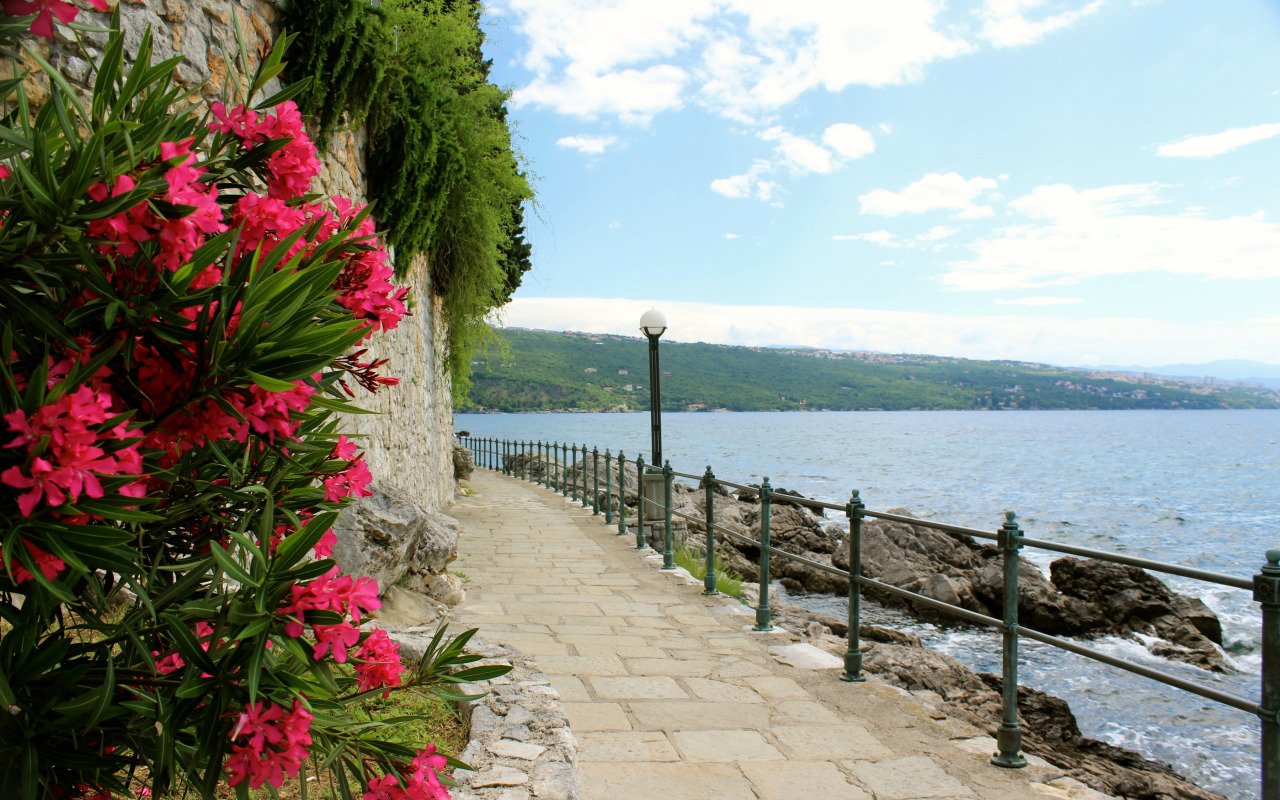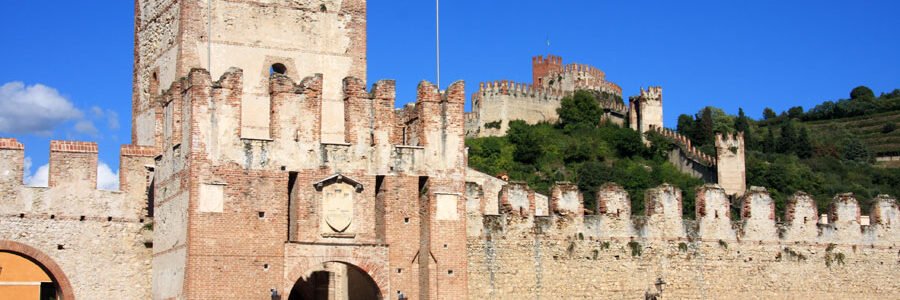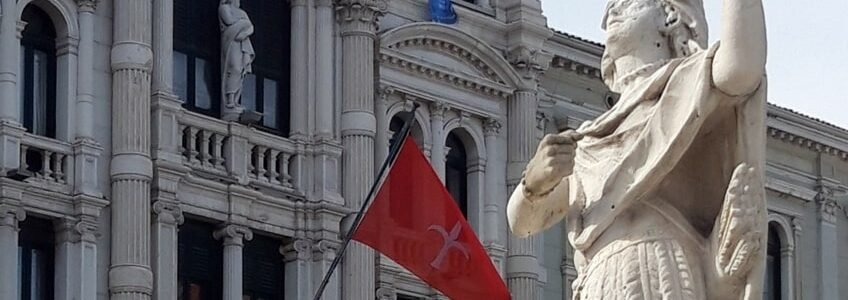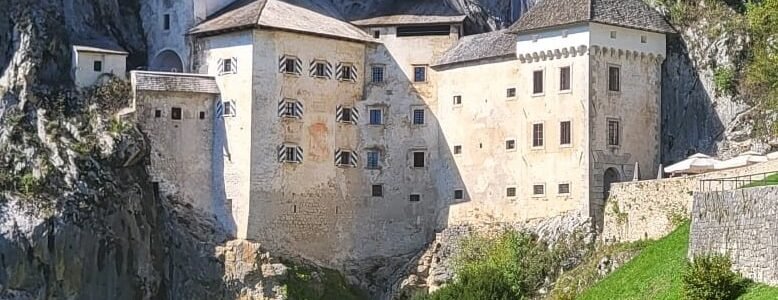Where Locals Swim in Opatija
Where Locals Swim in Opatija
Where Locals Swim in Opatija
Mornings Begin Before the Shade Moves
Ask any Opatijan when the day really starts and you’ll get the same answer: “Kad sunce još ne prži.” Just after six, Lungomare is still half in shadow and you can hear sneakers on stone long before voices. Pensioners claim the benches, stretch, then ease down steps beside Villa Amalia to take the first plunge. Nobody brings towels; salt dries faster than cotton. The water feels heavier at that hour—cool, dense, empty. If you show up late, you’ve missed the town’s quiet handshake.
Volosko: Waves, Not Loungers
North of the palm-lined promenade, Volosko’s breakwater cuts into deeper water favored by chefs finishing a night shift and teenagers escaping watchful parents. Here the seabed drops fast; one kick and you’re past the mooring buoys. Fishing boats idle close enough to trade jokes with swimmers. Concrete blocks wear algae stripes you can grip when the south wind kicks up. No music, no cocktails, only a kiosk selling still-warm pogača after eight. The rule is simple: carry your trash back up the stairs or be ready for a grandmother’s lecture.
Under the Pines at Črnikovica
Locals who need shade settle at Črnikovica. A low pine canopy leans over the sea wall, dropping resin-scented needles that stick to damp shoulders. Families spread newspapers instead of beach mats, roma children trade diving contests for half-finished ice creams, and someone always has a battered portable radio stuck between channels. If the Maestral wind turns rough, elders move into waist-deep water and hold a floating chat circle, feet off the rocks, hats still on. Swim long enough and a neighbor will press a fig into your palm without a word.
The Unmarked Steps Below Veprinac
Visitors photographing Villa Angiolina rarely notice a side alley that climbs toward Veprinac. Halfway up, thirty mossy steps drop back down to the tide line—no rail, no sign. At the bottom: flat limestone ledges, none wider than a mattress, all facing west. Students claim them near sunset with nothing but watermelon and two bottles of cheap Malvazija. Jumping here requires timing the surge; misjudge and you’ll scrape your shins. Nobody films it. The ledges are for bruises, not hashtags, and they empty as soon as the streetlights click on above.
Getting Here Sets the Pace
Many first-timers cruise in from the Istrian highway, but rhythm matters more than speed. Travellers landing in Venice at dawn often ride a direct Venice to Opatija transfer that trades airport clamor for Adriatic stillness before lunch. The two-and-a-half-hour slide down the Kvarner curve is its own decompression chamber: vineyards, karst cliffs, then the sudden blue. Arrive like that and you won’t race for a sunbed; you’ll drop your bag, slip into water, and let the road evaporate.
Ičići After Tour Boats Leave
Ičići’s main pier may look busy at noon, but wait until the excursion catamarans depart for Cres. By four, the marina settles into a low hum of rigging lines and gulls. Locals step out onto the wooden finger docks and slide into the channel between hulls. The water smells of rope tar and diesel—not unpleasant, just working water. Marina guards don’t mind; they nod if you keep clear of the stern props. Swim a hundred strokes toward the orange mooring ball and you’ll meet octogenarian Stipe, still knocking out a kilometre every day.
Škrbići: Stone Teeth and Quiet Currents
South of the better-known Slatina beach lies Škrbići, a ragged set of stone “teeth” with gaps wide enough to wedge a towel. You won’t find kiosks, showers, or playlist wars—only clear shallows and a lazy north-south drift. Locals float belly-up, letting the current carry them to the last rock, climb out, walk back along the path, and repeat. Kids practise flips off the taller “tooth” until elbows turn red. Dogs are unofficially welcome if they can handle slippery exits.
Why Flip-Flops Stay Home
Rubber soles shout “visitor.” Locals go barefoot over hot flagstones, trusting muscle memory to dodge barnacles. Calluses grow by June; by August, feet recognise every crack. It isn’t bravado—it’s practicality. Flip-flops catch on ladder rungs and drift away in swells. A true Opatijan keeps shoes dry and hands free for carrying a kilo of cherries bought on the walk home. If you need footwear, bring thin neoprene socks and wear them only for climbing the exit ladder at Istraga Rock, south of Costabella.
Food Happens After Salt
Swimming here isn’t a morning’s main event; it’s a prelude to eating. Locals leave water, towel off once, and head straight to Skalinada bakery for still-steaming burek. Salt on skin seasons the pastry; sun does the rest. Fishermen queue behind office clerks and developers on lunch break. Conversation stays light—yesterday’s football, tomorrow’s bura forecast. Nobody checks mirrors for sea-tossed hair; crust flakes down shirts, and that’s fine. By two-thirty, shutters drop, kitchens close, and the coast naps.
For Tide Charts and No-Frill Updates
Tourist sites push sunset cruises and rooftop cocktails, but swimmers watch currents and wind flags. Local forecasts, slipway repair notices, and algae bloom alerts appear without fanfare on the Grad Opatija maritime bulletin—linked under “sea status” on the municipal information page for Opatija. Bookmark it; the data is blunt but solid, updated after each harbour patrol round. Out-of-towners rarely look, which keeps the best hours uncrowded.
Final Lap
Evening closes like a dimmer switch. The sea warms a few degrees, gull cries stretch out, and Lungomare fills with promenading couples. Locals who swam at dawn return for one more dip, this time carrying ice cream instead of towels. Lights from hillside villas spark on, reflecting off slow ripples. You slip into water that feels familiar now—same salt, same floor, different hush. No lifeguards, no speakers, just breath and tide. Tomorrow you’ll know which rock to claim. And you won’t need flip-flops to reach it.
Where Locals Swim in Opatija
Where locals swim in Opatija isn’t found in brochures. It’s hidden behind cliffs, tucked between old piers, and whispered about during morning coffee. These places don’t sell cocktails — they offer solitude, salty air, and the sense that time has paused. Visitors arriving from Budapest or Salzburg might search for beaches; locals look for silence and shade.
Whether you’re reaching Opatija via a Budapest to Opatija transfer or stepping off a coastal drive from Slovenia, the best swims begin where the promenade ends — where stones replace sunbeds and waves have room to speak.
- Opatija to Hallstatt — trade saltwater for alpine stillness
- Salzburg to Opatija — direct arrival at the Adriatic’s edge
- Opatija to Bled — link two legendary waterscapes
- More about Opatija
- Opatija to Ljubljana — lake, sea, and back again
Where Locals Swim in Opatija: Not All Beaches Are Equal
- Crnikovica — where locals dive off stone walls into deep Adriatic blue
- Škrbići Beach — shaded, quiet, and largely ignored by tourists
- Behind Hotel Belvedere — natural rocks, crystal waters, no music
- Lido’s southern edge — the part without umbrellas or fees
- Morning swims near Volosko — solitude before breakfast
Escaping the Promenade: How Locals Avoid the Crowds
Where locals swim in Opatija isn’t a location — it’s a mindset
For detailed updates on hidden swim spots, check with the Opatija official tourism portal.
RECENT POSTS
- How to get from Trieste to Zagreb December 6, 2025
- How to get from Vienna to Venice November 30, 2025
- How to get from Vienna to Trieste November 22, 2025





























































Leave a Comment